Let Me Go: Excessive Restraint of Patients at College Hospital
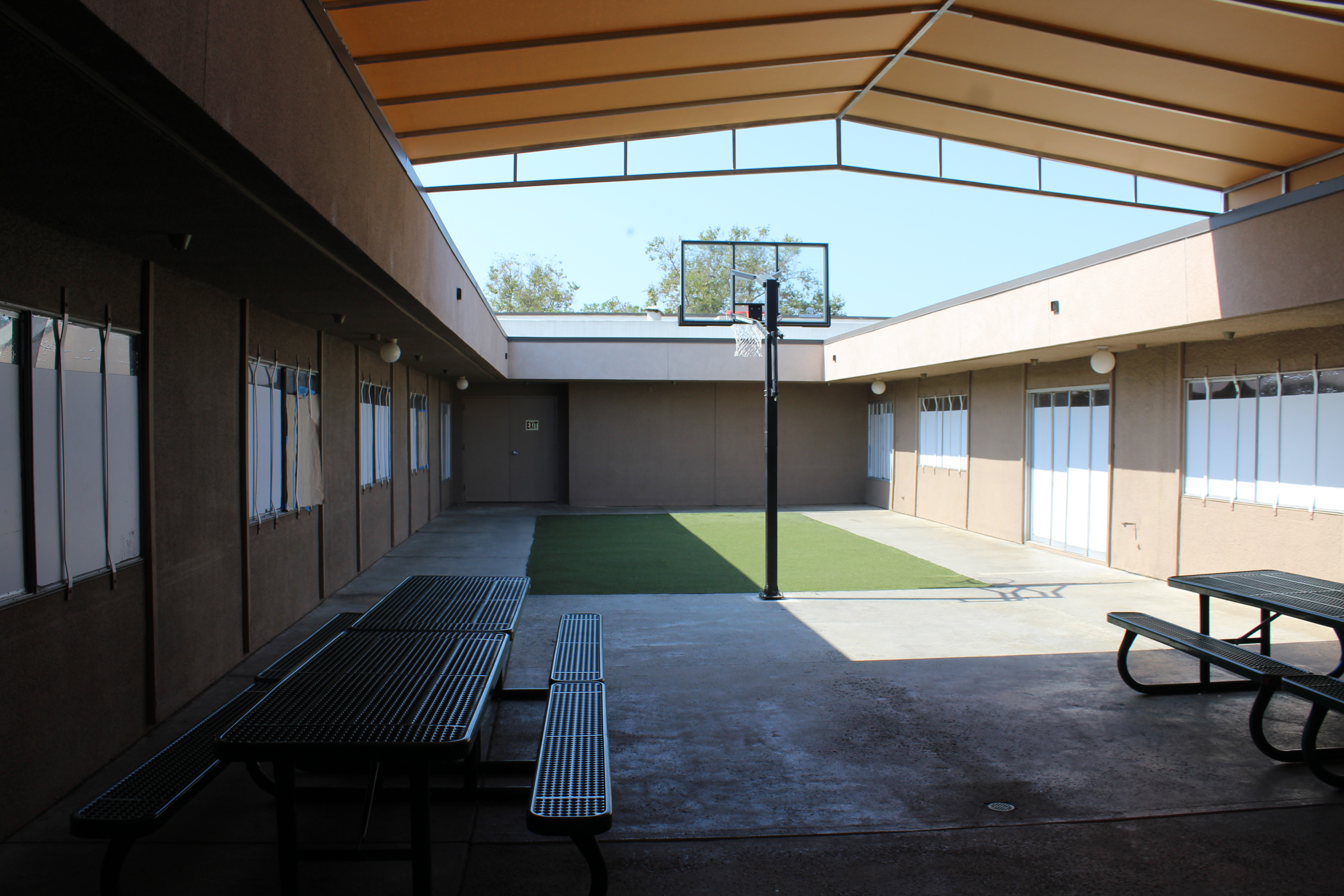
Let Me Go: Excessive Restraint of Patients at College Hospital
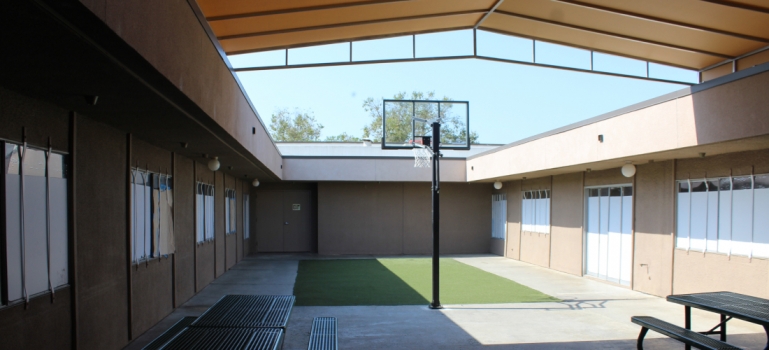
Since 1978, Disability Rights California (DRC) has advocated for reducing and eliminating the use of physical restraints on people with disabilities. Through our legislative and public policy efforts, DRC has advanced strict restraint standards in hospitals, nursing homes, schools, and other settings. At the same time, DRC has advocated for people with disabilities to be provided with up-to-date community-based treatment services in locations closest to their natural supports and service providers. Given the proper support and opportunity, nearly all people with disabilities can live in a community setting.
Let Me Go:
Excessive Restraint of Patients at College Hospital
Monitoring and Report by:Disability Rights California Investigations Unit
Richard Diaz, Adeyinka Glover, Liz Logsdon, Emely Lopez, Vanessa Ramos, Paula Sandoval, Robert Reyes Villagómez Expert Consultants:
Edward S. Miguel, EdD, BCBA
Melaura Erickson Tomaino, PhD, BCBA-D
Introduction
Since 1978, Disability Rights California (DRC) has advocated for reducing and eliminating the use of physical restraints on people with disabilities. Through our legislative and public policy efforts, DRC has advanced strict restraint standards in hospitals, nursing homes, schools, and other settings.
At the same time, DRC has advocated for people with disabilities to be provided with up-to-date community-based treatment services in locations closest to their natural supports and service providers. Given the proper support and opportunity, nearly all people with disabilities can live in a community setting.
Executive Summary
Disability Rights California (DRC) is the state’s designated Protection and Advocacy system, charged with protecting the rights of people with disabilities.1 DRC has the legal authority to inspect and monitor conditions in facilities that provide care and treatment to people with disabilities.2
DRC's Investigations Unit turned our attention to College Hospital in Cerritos after observing high rates of restraint and seclusion through monthly data reports.3 College Hospital, opened in 1973, is a private psychiatric hospital.4 State statute requires that certain types of facilities, including College Hospital, provide DRC with a monthly report on the number and duration of incidents of seclusion and behavioral restraint and the number of times facility staff administer involuntary emergency medication.5 In DRC's regular review of these monthly reports, we identified a long-standing pattern of frequent and lengthy restraint incidents at College Hospital.

People who have intellectual and developmental disabilities (IDD) along with a significant mental illness are often referred to as having a “dual diagnosis”. At College Hospital, four units provide care to people with dual diagnosis who are experiencing a mental health crisis.
Providing treatment for people in crisis is complicated. Factors such as disability, race, past trauma, and economic status further complicate what methods or forms of treatment are most appropriate. A common method of managing behaviors associated with crises is the use of seclusion and restraints. Seclusion and restraints isolate or physically restrict an individual deemed dangerous to others or themselves. Until you or someone close to you is restrained or secluded, you may not even be aware that there is a restraint bed or seclusion room at your local school, nursing home, or other place where people with disabilities live or receive services.
Beginning in July 2022, DRC conducted on-site monitoring of College Hospital’s units serving people with dual diagnosis (“the DDMI units”).6 We inspected all facility areas accessible to residents, including bedrooms and health care treatment, recreation, and education areas. We interviewed patients who experienced restraint incidents that lasted over two hours. We also interviewed College Hospital staff, such as program administrators, nurses, and behavioral analysts, who answered questions about their facilities and programs. During our investigation, we reviewed thousands of pages of documents including individual client files, facility policies, and training materials.
DRC retained two Board Certified Behavior Analysts (BCBAs) as experts to undertake detailed evaluations of people living at College Hospital. These experts performed site visits, reviewed individual records and video footage, and conducted confidential patient interviews. The experts also reviewed College Hospital’s policies and procedures related to seclusion and restraint. They provided DRC with detailed written findings and recommendations, which are incorporated throughout this report.
Based on our investigation, it is our determination that College Hospital excessively restrains patients and does not consistently adhere to federal and state regulations or its own policies. College Hospital must take steps to address the harmful conditions and treatment failures that affect people with disabilities under its care.
Key Finding #1
Patients at College Hospital experience improper and excessive use of seclusion and restraints.
Key Finding #2
College Hospital fails to assess and provide patients with adequate, individualized behavioral plans.
Key Finding #3
College Hospital fails to provide patients with a therapeutic environment of care.
Key Finding #4
College Hospital fails to provide adequate transition planning for patients.
College Hospital Cerritos
Background
College Hospital Cerritos is a private acute psychiatric hospital in Cerritos, California.7
College Hospital’s DDMI units comprise four units: three for adults and one for youth. The adult units have a combined 56 beds, and the youth unit has 12 beds, for a total of 68 beds. The DDMI units are secure, locked units where patients have restricted movement and cannot leave without facility approval.
College Hospital accepts patients under a variety of legal holds.8 In 2023, the average length of stay of patients in the entire facility was 19.8 days, compared to the statewide average of 6.4 days.9 During our investigation, we encountered patients who had been at College Hospital for years. College Hospital’s net revenue for inpatient services in 2023 was over $60 million.10
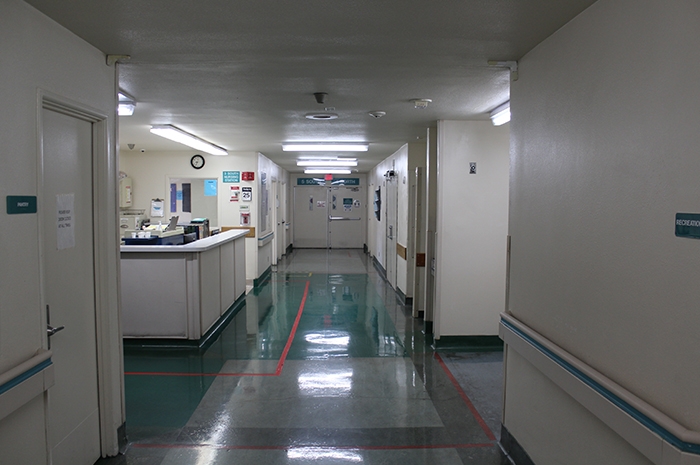
Licensing, Certification, and Legal Requirements
College Hospital is licensed by the California Department of Public Health (CDPH) as an Acute Psychiatric Hospital and designated by the Department of Health Care Services (DHCS) as an Institution for Mental Disease (IMD).11 College Hospital is also certified by the Center for Medicare and Medicaid Services (CMS) and is subject to its federal regulations.12
Patient Information
On a sampled day in January 2025, College Hospital’s DDMI units had a total census of 68 patients, 53 of whom were people served by regional centers.13 College Hospital’s demographic data showed that on that date in January, 41% of patients were Latinx/Hispanic, 35% were White, 10% were Black/African American, 4% were Asian, and 10% were other races. 66% of patients were male, and 34% were female. 56 patients were adults and 12 were youth. The DDMI units were at full capacity.
Patients at College Hospital Experience Improper and Excessive Restraint and Seclusion
Our investigation found that College Hospital uses restraint frequently and for long periods, many times without proper justification. We saw a pattern of staff overly relying on pharmaceutical drugs to chemically restrain patients. Additionally, we found that College Hospital staff regularly do not attempt to de-escalate or use less restrictive interventions before using restraint or seclusion. College Hospital’s systemic issues regarding restraint and seclusion result in the abuse and neglect of their patients.
Legal Definitions of Restraint & Seclusion:
Facilities participating in Medicare or Medicaid must comply with CMS rules governing restraint and seclusion. These rules define restraint and seclusion as follows:
-
Physical Restraints14:
Any manual method, physical or mechanical device, material, or equipment that immobilizes or reduces the ability of a patient to move their arms, legs, body, or head freely.15 -
Chemical Restraints:
A drug or medication when it is used as a restriction to manage the patient's behavior or restrict the patient's freedom of movement and is not a standard treatment or dosage for the patient's condition.16 -
Seclusion:
The involuntary confinement of a patient alone in a room or area from which the patient is physically prevented from leaving. Seclusion may only be used for the management of violent or self-destructive behavior.17

These rules further restrict the use of restraint and seclusion. According to CMS, facilities may only impose restraint or seclusion to ensure the immediate physical safety of the patient, a staff member, or others, and it must be discontinued at the earliest possible time.18 Restraint or seclusion may only be used when less restrictive interventions have been determined to be ineffective in protecting the patient, a staff member, or others from harm.19 Furthermore, facilities must use the least restrictive type of restraint or seclusion that will be effective.20
Excessive Seclusion and Restraint at College Hospital Cerritos:
The California Department of Developmental Services (DDS) collects and publishes data on restraint incidents from regional center vendors. From January 1, 2024, to June 1, 2024, there were 2,983 unique restraint incidents among the state’s vendors.21 College Hospital recorded 815 restraint incidents, constituting over one in four of California restraint incidents during the reporting period.22 This is an average of 5.4 restraint incidents per day.
The table below shows data collected by DDS from January 2022 to December 2024. It compares restraint data from College Hospital to the average of all other vendor data collected by DDS, with the College Hospital data points removed. The disparity is obvious.
| Duration of Restraint Incidents | College Hospital | California Average23 |
|---|---|---|
| Over 4 hours | 60 | 1 |
| Over 2 hours | 486 | 4 |
| Average restraint duration | 108.6 minutes | 4.8 minutes |
Physical Restraints
A frequently used method of restraint at College Hospital is “five-point restraint,” where a patient is held down on a bed using straps that are fastened to a patient's wrists (two points), ankles (two points), and chest (one point). Restraint rooms are separate from the general population, and patients are escorted to them by staff who use physical holds to immobilize the patient and place them into five-point restraints. We also documented and observed the use of leg shackles for transportation and locked seclusion rooms for isolating patients.
Patients at College Hospital also described staff holding them in prone restraint. During prone restraint, the person being restrained is face down. At College Hospital, patients described staff holding them face down on surfaces such as the floor or a bed. We reviewed video footage corroborating an incident of prone restraint. The usage of prone restraint carries high risks due to the chance of asphyxiation if there is too much pressure on the back.24 State regulations dictate that an acute psychiatric hospital “shall avoid the deliberate use of prone containment techniques whenever possible, utilizing the best practices in early intervention techniques, such as de-escalation.”25
William26 is a patient at College Hospital and, as of this writing, is awaiting community placement. His current length of stay at College Hospital is over six years. We met with William multiple times during our investigation. On one occasion, when our team asked about a recent restraint incident, his excitement in speaking with us and positive demeanor immediately shifted. He began visibly shaking, most notably in his hands. His speech shortened from complete sentences to a few words at a time, and he began to repeat, “I don't want restraint,” while rocking in his chair.
Chemical Restraints
At College Hospital, staff utilize antipsychotic medications such as haloperidol (Haldol) and lorazepam (Ativan) as emergency medications when they determine patients are a threat to themselves or others. These medications can have serious side effects, such as stiffening or spasming of the muscles and confusion due to severe nervous system reactions.27 In our investigation, we found multiple instances of staff administering both medications along with diphenhydramine (Benadryl) simultaneously as a form of chemical restraint. This combination of drugs may result in adverse effects, including oxygen desaturation and low blood pressure.28 Administering these three medications together is also linked to a higher utilization of physical restraint and longer lengths of stay for patients.29
DRC's investigation found examples of staff at College Hospital administering this combination of medications just minutes before physically restraining patients in five-point restraints. When we reviewed William’s records, we saw in physician logs that after days of chemical restraint, one doctor noted he was drooling and experiencing side effects of muscle stiffening as evidenced by his gait and posture. William’s doctor also stated that William lost 40% of his body weight over the prior 12 months.
For Carter, exposure to restraint began at intake. During the first two months of his stay at College Hospital, he experienced 22 total instances of restraint. Thirteen of those instances involved a chemical restraint in combination with either a physical hold by staff or a mechanical restraint involving a restraint bed. The average duration of the mechanical restraints was 74 minutes. After reviewing Carter’s records, we found that College Hospital staff restrained him or injected him with antipsychotic medications once a day for a cumulative two weeks in addition to his regular medication regimen.
De-Escalation
Federal regulations require that facilities may only use restraint and seclusion when less restrictive interventions, such as de-escalation, are not effective to protect patients or staff members from harm,30 and studies have found that de-escalation techniques reduce the incidence and severity of aggression and the use of physical restraints in acute psychiatric units.31
Our investigation found that College Hospital staff did not always engage in de-escalation techniques when patients began to demonstrate challenging behaviors and instead proceeded directly to place patients in restraints. During a facility tour, while accompanied by our experts, we did not observe mental health supports or interventions. In fact, we noted patients in distress but did not see mental health providers applying appropriate de-escalation strategies. It is difficult to speak about the quality or specifics of de-escalation techniques due to a lack of detailed documentation in College Hospital incident reports combined with the fact that we did not see these practices during on-site monitoring visits.
We and our experts reviewed video footage involving a patient named Jason. In the video footage, Jason was in a seclusion room by himself, attempting to de-escalate by alternately sitting on the bed and pacing the room. Jason appeared to be speaking to people outside the room and out of view during this period. Jason calmly took a seat on the bed when eight staff members entered the room and placed him into five-point restraints. At no point was Jason exhibiting dangerous behaviors that would constitute a danger to himself or others. When staff entered the room, they went straight to the highest restriction intervention of restraint and did not show any attempt at de-escalation.

Susie is a patient in College Hospital's DDMI unit who has experienced frequent chemical restraints and lengthy physical restraints. In one such incident, Susie was distressed to learn that her placement out of College Hospital would be at another locked facility. Upon learning this, staff noted she was “anxious and aggressive,” recording that she removed room number signs from the wall and attempted to go to a different unit to “destroy” a telephone. Staff members then chemically restrained her by injecting her with antipsychotics and diphenhydramine. Ten minutes later, they placed her in seclusion and five-point restraints for 20 minutes because, according to their assessment, she was a danger to others.
In another incident, Susie was described by staff as “cursing, yelling, threatening” and kicking and banging her fists against the walls. Staff noted in a Seclusion & Restraint Assessment Packet that Susie did not meet restraint criteria as she was not dangerous to others or herself. Despite this, Susie was secluded and physically restrained for two-and-a-half hours.
Studies show that restraint negatively impacts both staff and patients due to the psychological effects and lack of support following restraint events.32 A 2019 systematic review found that 25-47% of in-patient psychiatric patients reported post-traumatic stress disorder following restraint, adding to increased recovery times and length of stay.33 College Hospital must find alternatives to using restraint and utilize best practices that support patients in their treatment goals. When College Hospital staff do apply restraint and seclusion, they must comply with federal and state regulations—only after it becomes clear that the patient is a danger to themself or others and staff have attempted all other means of intervening should staff apply the least restrictive method of restraint or seclusion, and its use should be discontinued at the earliest possible opportunity.
Recommendations
- Eliminate the use of prone restraints.
Prone restraints are dangerous and can lead to death or severe injury. - Minimize the use of concurrent restraints.
Administering chemical restraints immediately before physical restraints makes it impossible to determine the efficacy of the first restraint. College Hospital should establish a minimum evaluation time before deciding whether to utilize an additional highly restrictive intervention to prevent excessive restraints. - Work to eliminate the use of all restraints.
Minimizing highly restrictive interventions must be an organizational goal to reduce risk to staff and patients. There are evidence-based approaches that eliminate the need for restraint with proper behavioral intervention plans, effective programming, and a therapeutic environment. - Promote mental health supports and de-escalation as the primary crisis response.
College Hospital must change its culture to one where staff only use restraint as a last resort. College Hospital should regularly train its staff to implement mental health supports that assist in de-escalation and prevent significant escalations in its patients. Additionally, mental health professionals should be present during crises to ensure appropriate approaches to disruptions of baseline behaviors.
College Hospital Fails to Provide Patients with Adequate, Individualized Behavioral Plans
Generally, acute psychiatric hospitals treat patients experiencing a behavioral crisis until they are stable and ready to integrate back into the community. Our investigation revealed, however, that patients have prolonged stays at College Hospital. We have concluded that patients languish at College Hospital in part because the facility fails to provide adequate behavioral treatment.
College Hospital claims to treat patient behavior through Applied Behavioral Analysis (ABA), an evidence-based approach that teaches individuals with IDD various skills to improve socially significant behavior.34 Our experts, however, determined that its program lacks some of the necessary therapeutic components of a functioning ABA system.
College Hospital fails to conduct comprehensive functional behavioral assessments (FBAs) upon admission. Behavioral therapists use FBAs to understand the function and purpose of a person's specific, interfering behavior and the factors that contribute to that behavior occurring or not.
The goal is to develop effective positive behavioral interventions, supports, and other strategies to mitigate or eliminate the interfering behavior.35 Without baseline FBA data, College Hospital’s behavioral therapists do not follow treatment protocols to observe and track behavior. Their notes show that they instead often inaccurately document generic behavioral antecedents like “agitated” or record “unknown.”
Qualified providers like Board-Certified Behavior Analysts (BCBAs) can use FBA results to develop individualized Behavioral Intervention Plans (BIPs). College Hospital, however, uses recycled language and generic information in its BIPs despite its patients' different backgrounds, diagnoses, and behavioral goals. DRC identified other essential documents containing boilerplate language, such as progress and social worker notes used for transition and discharge planning.
College Hospital fails to develop and implement replacement behaviors. According to our experts, appropriately implemented BIPs should teach people how to cope with stressors and practice replacement behaviors when in a stable state of mind to help them prepare for a crisis. However, our experts observed that College Hospital's behavioral interventions are entirely reactive, representing responses to interfering behaviors rather than applying positive staff responses to demonstrate replacement behaviors.
During an unannounced visit to College Hospital’s DDMI unit, we observed a group of 10-15 patients during their activity therapy and education session held on the patio. One staff member facilitated an activity using a deck of cards. At the same time, some patients sat around the staff on a picnic table, others wandered around the basketball court, and a few sat by themselves on the floor or talked to peers. The behavioral therapist updated a chart on patient attendance and behavior but did not engage with patients directly to review coping or replacement behaviors.
Our experts determined that these failures are likely to cause patients to regress, further prolonging their stays and contributing to the facility's high counts of seclusion and restraint and excessive use of emergency medication to handle behavioral issues. College Hospital's failure to provide adequate behavior plans has left patients stranded with limited chances of finding a community placement.
Recommendations
- Develop and implement comprehensive behavioral plans for all patients in the DDMI units. These plans should:
- Be individualized to each patient’s needs.
Each patient should have behavioral goals based on skill deficits and a plan for staff to teach those skills. - Include a treatment plan focused on positive behavioral interventions.
The BIP needs to define replacement behaviors and reinforcement schedules clearly. Detailed documentation of the antecedent is essential to finding an appropriate replacement behavior to fulfill the need. - Be regularly updated and modified as needed.
Every time a patient engages in a new challenging behavior, an FBA must be completed to update the BIP and increase replacement behaviors.
- Be individualized to each patient’s needs.
- Increase patient engagement in learning or developing skills for community integration.
The more time patients are engaged in learning skills, the less time they will spend engaging in challenging behaviors. Patients should be engaged in activities that will prepare them for living independently. College Hospital should coordinate with the California Department of Rehabilitation (DOR), regional center vendors, and the local school district to provide patients with educational opportunities, allowing them to plan for their futures. - Invest resources to train all staff in function-based assessment and intervention.
FBAs focus on determining why challenging behavior manifests by identifying the variables that contribute to the emergence of the behavior. Trained staff will be able to identify the causes of disruptive behaviors and address them, achieving treatment goals of eliminating interfering behaviors.
College Hospital Fails to Provide Patients with a Therapeutic Environment of Care
College Hospital’s environment of care is outdated, restrictive, and not trauma-informed. The College Hospital environment does not make patients feel safe enough to engage and develop the necessary skills to succeed in the community. College Hospital has not adequately enhanced or adapted its units to reflect patients' needs.
College Hospital’s Patient Units are Outdated and Restrictive
The overall design of the DDMI units creates a hospital-like atmosphere that appears to be decades old. In addition to its physical structure, the facility is very restrictive regarding what is allowed on the walls and how patients can personalize their living spaces, adding to the very clinical environment. Most units at College Hospital have bedrooms with windows facing a courtyard.
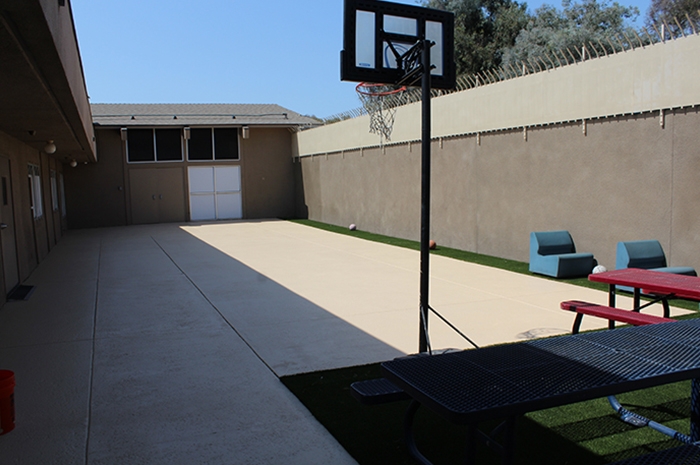
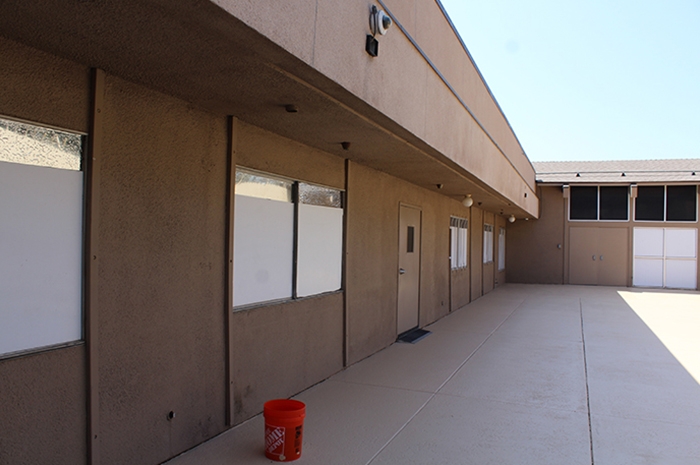
However, the windows are mostly covered, significantly limiting natural light entering patient rooms. There is growing research regarding the physical environment in mental health facilities and the importance of striking a balance between ensuring safety and providing a therapeutic atmosphere.36
The recreation areas at College Hospital are also sparse. The walls are bare, and there are few natural features. During one of DRC's visits, staff showed us a newly renovated recreation area they said would be the model for the other units. The renovations included removing plants along a fence line and building a tall concrete wall topped with barbed wire. The converted recreation yard looked more like one found in a jail than one in a facility for therapeutic treatment.
The environment in patient spaces is a stark contrast to the staff areas. While walking through staff-only areas, DRC observed that College Hospital made numerous environmental improvements. Staff areas have wood floors, couches, a fireplace, and generally a more modern, updated appearance. College Hospital could substantially improve the patient environment with similar renovations.
Our experts noted that College Hospital's physical plant lacks areas for patients to practice habits that lead to a successful day-to-day life outside of the College Hospital setting. The experts recommend that College Hospital move away from a hospital-like atmosphere to one that fosters patient ownership of their spaces as well as individuality. The experts note that spending time decorating and organizing their spaces is time away from challenging behavior. Investment in upgraded patient areas will have benefits for patients and staff.
According to our experts, creating spaces for patients to escape from overstimulation is essential. Research on the topic of sensory integration and sensory rooms promotes the benefits of these types of spaces for patient regulation.37 College Hospital does not adequately provide these spaces, which leaves patients without another proven tool to help build skills for their lives beyond this facility. Our monitoring visits and review of records revealed several instances of patient escalation that may have been countered had there been an intervention like a sensory room available as part of a patient treatment plan.
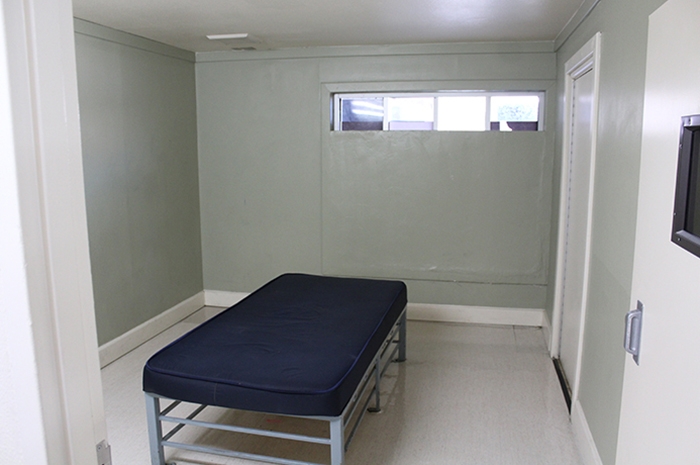
College Hospital Does Not Provide a Trauma-Informed Environment of Care
A trauma-informed approach provides appropriate medical or mental health services in a way that recognizes a person’s personal history and experience with trauma into account.38 The lack of trauma-informed care is another way that College Hospital fails to provide a therapeutic environment for patients, resulting in an environment that promotes excessive usage of highly restrictive interventions
The Substance Abuse and Mental Health Services Administration (SAMHSA) developed principles to ensure that service providers take trauma into account and do not re-traumatize patients when providing them with services.39 The first of these principles is safety, which includes ensuring that people “feel physically and psychologically safe” and that the “physical setting is safe.”40 Implementation guidelines also discuss the importance of a physical environment “that promotes a sense of safety and collaboration…through openness, transparency, and shared spaces.”41
As discussed above, College Hospital’s physical environment is outdated and restrictive. Our experts identified the need for a safe environment, including spaces for patients to practice skills and de-escalate. The experts noted the importance of opportunities for engagement or observation and relaxation. These safe places are essential for patients to develop skills to help them in future placements.
College Hospital needs to adapt to its current population and create an environment for quality treatment. While facilities like this are generally intended for short lengths of stay, many patients reside at College Hospital for long periods, and improvements to the environment of care are necessary.
Recommendations
- Develop and implement a plan to modify existing units or create new spaces.
College Hospital must update its environment of care to be more suitable for long-term patients awaiting placement. - Move towards a patient-centered, home-like care setting.
College Hospital is the patients’ home away from home, and the care environment should reflect that. A home-like environment will allow patients to practice, learn, and grow to prepare them for less restrictive settings. - Create accessible sensory areas.
Sensory rooms allow patients to reset before returning to a more stimulating environment and are an important tool in self-regulation. Patients should be able to self-select to visit these areas or not.
College Hospital Fails to Provide Adequate Transition Planning for Patients
College Hospital fails to provide patients with adequate transition planning, making discharge difficult. As a result of inadequate transition planning, patients are stuck in a more restrictive setting compared to a community-based placement. We encountered patients who resided at the hospital for years despite a California law that limits stays at IMDs for people with IDD to a maximum of 13 months.42
We met several patients with inadequate transition plans that affected their ability to leave the facility. In one case, College Hospital found a patient ready for discharge over two years before our review, but as of the release of this report, they are still living at the hospital. During this nearly two-and-a-half-year span, College Hospital frequently restrained and secluded the patient. College Hospital found another patient ready to leave more than a year before we met them. In this patient’s case, a physician wrote that they had “no disruptive behavior” and “no mood swing or paranoia,” as documentation that they were ready for discharge into the community.
Similarly, our experts reviewed transition plans for multiple patients and found them incomplete. Transition plans did not exist or included boilerplate language that did not focus on the individual patient. They identified a lack of clear transition criteria or goals, leading to extended durations of stay.
We understand that transitioning patients to the community is not always entirely up to College Hospital as, for patients with IDD, the Department of Developmental Services and regional centers play essential roles in finding community placements. However, College Hospital must provide treatment and discharge planning for patients irrespective of their length of stay. Additionally, not all College Hospital patients are served by regional centers and do not have the same supports to navigate placement.
College Hospital should create or update transition plans as soon as possible, ideally updating plans for new patients upon admission. While patients await placement, College Hospital should continue providing evidence-based, ethical, patient-centered care.
Recommendations
- Start transition planning as early as possible.
Transition planning should be done immediately upon intake, or College Hospital should only accept patients with a transition plan. - Meaningfully engage patients in the transition planning process.
Patients need to feel involved in developing skills and meeting program goals. - Redesignate patient areas based on a person’s readiness to leave.
As patients' behavior improves and they gain skills that prepare them to reenter the community, College Hospital should move them to an environment that supports continued progress toward discharge. Demonstrating that patients are engaging in educational programs and living in a less restrictive environment can make their referral packets more desirable for increased acceptance by community placements. - Designate or hire a placement navigator.
Having a specific role dedicated to seeking placements for patients who are ready to transition out of College Hospital will create accountability in the transition process and reduce workload issues for other staff.
Conclusion
Conditions within College Hospital’s DDMI units pose serious risks to people with disabilities. The situation demands action. College Hospital must critically review the use of restraint and seclusion in its facility and work to significantly reduce it, with an end goal of eliminating it entirely. Access to adequate behavioral treatment and the creation of a trauma-informed environment of care must be a priority. Finally, College Hospital must provide patients with transition planning to ensure people with dual diagnosis live in the least restrictive environment and have an opportunity to thrive in the community.
Types of Legal Commitment Statuses at College Hospital
- WIC 5150 (72 hours):
An adult with a mental health disorder can be taken into custody for a 72-hour assessment, evaluation, or crisis intervention if they are dangerous to themselves or others or are gravely disabled. Applies only to adults. - WIC 5585 (72 hours):
Similar to WIC 5150 but applies to children. - WIC 5250 (14 days):
A person with a mental health disorder subject to a 5150 or court-ordered evaluation may be subjected to intensive treatment for 14 days. - WIC 5260 (14 days):
A WIC 5150, 5585, or 5250 hold may be extended 14 days for intensive treatment, including if the person is a suicide risk. - WIC 6500 (6 months initially, 13 months maximum):
A person with a developmental disability may be placed at an IMD by a regional center if they are a danger to themselves or others. A district attorney then submits a petition with supporting documentation from a regional center. A granted court order automatically expires in six months unless an extension is granted for another period of six months. Lastly, the placement may be extended for a final month. - 20 USC 1412(a)(5)(A) School district placement (indefinite):
A child’s school district may determine through the IEP process that the least restrictive environment based on the child’s needs is the youth wing at College Hospital. College Hospital is part of the ABC Unified School District, which is responsible for the education of students during their admission. - WIC 5000 Conservatorship (indefinite):
A Lanterman Petris-Short (LPS), limited, or general conservator with court-ordered authority to determine where a person subject to a conservatorship resides, can decide placement, including at College Hospital. - Voluntary (indefinite):
A person can voluntarily admit themselves for a psychiatric hold and can discharge themselves. While some College Hospital patients are in the DDMI unit “voluntarily,” some are there because of other types of holds expiring and a lack of community placement options.
- 1. CAL. WELF. & INST. CODE § 4900; 42 U.S.C. §§ 10802(1), 10802(5).
- 2. 42 U.S.C. § 10805(a)(3); 42 C.F.R. § 51.42(b); CAL. WELF. & INST. CODE § 4902(b)(2).
- 3. College Health Enterprise operates multiple facilities under the name “College Hospital.” Unless otherwise specified, “College Hospital” refers to College Hospital Cerritos throughout this report.
- 4. CH Cerritos, COLLEGE HOSPITAL CERRITOS, https://chc.la/ch-cerritos/ (last visited Feb. 25, 2025).
- 5. CAL. WELF. & INST. CODE § 4659.2(c).
- 6. Developmental Delay Services (DDMI), COLLEGE HOSPITAL CERRITOS, https://chc.la/developmental-delay-services-ddmi/ (last visited Feb. 25, 2025).
- 7. College Hospital - HCAI, CALIFORNIA DEPARTMENT OF HEALTH CARE ACCESS AND INFORMATION, https://hcai.ca.gov/facility/college-hospital/ [hereinafter HCAI Report]; The HCAI Report relies on data from reporting period Jan. 1, 2023 through Dec. 31, 2023.
- 8. See Types of Legal Commitment Statuses at College Hospital
- 9. HCAI Report, supra note vii.
- 10. Id.
- 11. Facilities and Programs Defined as Institutions for Mental Diseases (IMDs), CALIFORNIA DEPARTMENT OF HEALTH CARE SERVICES (Feb. 2025), https://www.dhcs.ca.gov/services/MH/Documents/Qtr-1-2025-IMD.pdf.
- 12. 42 C.F.R. § 482.13.
- 13. The Department of Developmental Services (DDS) coordinates and delivers services for Californians with developmental disabilities through a statewide network of 21 community-based, non-profit corporations known as regional centers. Regional centers provide assessments, determine eligibility for services, and offer case management services. Regional Centers, DEPARTMENT OF DEVELOPMENTAL SERVICES, https://www.dds.ca.gov/rc (last visited Mar. 3, 2025); CAL. WELF. & INST. CODE § 4621.
- 14. CMS Conditions of Participation do not differentiate between “physical” and “chemical” restraints—they call both “restraint" and provide the following two definitions. For purposes of this report, when we refer to physical and chemical restraints, we refer to these two definitions of restraint from the CMS Conditions of Participation.
- 15. 42 C.F.R. § 482.13(e)(1)(i)(A).
- 16. Id. § 482.13(e)(1)(i)(B).
- 17. Id. § 482.13(e)(1)(ii).
- 18. Id. § 482.13(e).
- 19. Id. § 482.13(e)(2).
- 20. Id. § 482.13(e)(3).
- 21. Restraint Data, DEPARTMENT OF DEVELOPMENTAL SERVICES, https://www.dds.ca.gov/transparency/facts-stats/restraint-data (last visited Feb. 25, 2025).
- 22. Id.
- 23. This average reflects the data set with all data from College Hospital removed.
- 24. Leslie Morrison, Paul B. Duryea, Charis Moore & Alexandra Nathanson-Shinn, Lethal Hazard of Prone Restraint: Positional Asphyxiation, 2002, PROTECTION & ADVOCACY, INC. (former name of DISABILITY RIGHTS CALIFORNIA), https://www.disabilityrightsca.org/public-reports/lethal-hazard-of-prone-restraint-positional-asphyxiation.
- 25. CAL. HEALTH & SAFETY CODE § 1180.4(f).
- 26. All patient names are pseudonyms to protect their privacy.
- 27. Akram Mokhtari, Olivia Yip, Judith Alain & Simon Berthelot, Prophylactic Administration of Diphenhydramine to Reduce Neuroleptic Side Effects in the Acute Care Setting: A Systematic Review and Meta-Analysis, 60 JOURNAL OF EMERGENCY MEDICINE 165-174 (Feb. 2021), https://pubmed.ncbi.nlm.nih.gov/33131965.
- 28. Trevor Jeffers, Brenna Darling, Christopher Edwards & Nina Vadiei, Efficacy of Combination Haloperidol, Lorazepam, and Diphenhydramine vs. Combination Haloperidol and Lorazepam in the Treatment of Acute Agitation: A Multicenter Retrospective Cohort Study, 62 JOURNAL OF EMERGENCY MEDICINE (2022), https://www.jem-journal.com/article/S0736-4679(22)00057-9/abstract.
- 29. Id.
- 30. 42 C.F.R. § 482.13(e)(2).
- 31. Andreja Celofiga, Blanka Kores Plesnicar, Jure Koprivsek, Miha Moskon, Dominik Benkovic & Hojka Gregoric Kumperscak, Effectiveness of De-Escalation in Reducing Aggression and Coercion in Acute Psychiatric Units. A Cluster Randomized Study, 13 FRONTIERS IN PSYCHIATRY (2022), https://doi.org/10.3389/fpsyt.2022.856153.
- 32. Hannah Butterworth, Lisa Wood & Sarah Rowe, Patients' and staff members' experiences of restrictive practices in acute mental health in-patient settings: systematic review and thematic synthesis, 8 BJPSYCH OPEN (Oct. 2022), https://pmc.ncbi.nlm.nih.gov/articles/PMC9634587.
- 33. Marie Chieze, Samia Hurst, Stefan Kaiser & Othman Sentissi, Effects of Seclusion and Restraint in Adult Psychiatry: A Systematic Review, 10 FRONT PSYCHIATRY (July 2019), https://pubmed.ncbi.nlm.nih.gov/31404294.
- 34. JOHN COOPER, TIMOTHY HERON & WILLIAM HEWARD, APPLIED BEHAVIOR ANALYSIS(3rd ed. 2021).
- 35. U.S. DEP’T OF EDUC., USING FUNCTIONAL BEHAVIORAL ASSESSMENTS TO CREATE SUPPORTIVE LEARNING ENVIRONMENTS 5-6 (Nov. 2024), https://sites.ed.gov/idea/files/Functional-Behavioral-Assessments-11-19-2024.pdf.
- 36. Laura Rodríguez-Labajos, Joanne Kinloch, Susan Grant & Geraldine O'Brien, The Role of the Built Environment as a Therapeutic Intervention in Mental Health Facilities: A Systematic Literature Review, 17 HERD (Feb. 2024), https://pmc.ncbi.nlm.nih.gov/articles/PMC11080396.
- 37. Charles C. Dike, Jerilynn Lamb-Pagone, David Howe, Paul Beavers, Barbara A. Bugella & Marc Hillbrand, Implementing a program to reduce restraint and seclusion utilization in a public-sector hospital: Clinical innovations, preliminary findings, and lessons learned, 18 PSYCHOLOGICAL SERVICES (2021), http://dx.doi.org/10.1037/ser0000502.
- 38. SAMHSA’s Concept of Trauma and Guidance for a Trauma Informed Approach, SUBSTANCE ABUSE AND MENTAL HEALTH SERVICES ADMINISTRATION 2-3 (Oct. 2014), https://library.samhsa.gov/product/samhsas-concept-trauma-and-guidance-trauma-informed-approach/sma14-4884.
- 39. Id. at 10-11.
- 40. Id. at 11.
- 41. Id. at 13.
- 42. CAL. WELF. & INST. CODE § 6500(c)(3).




